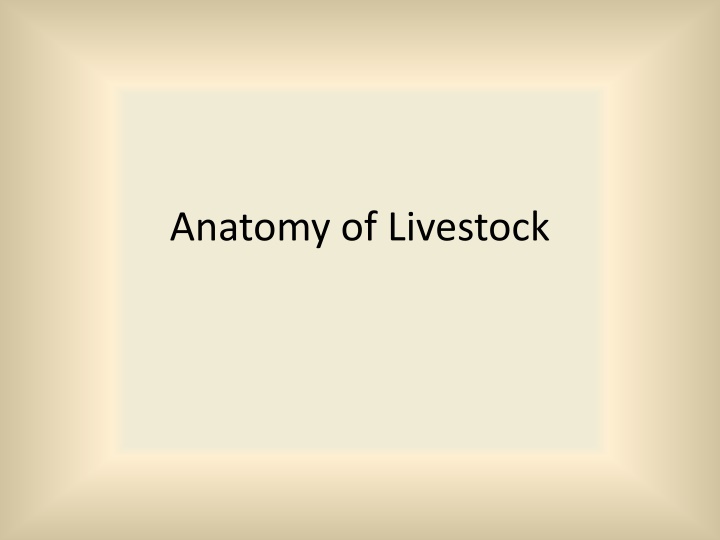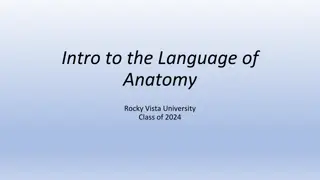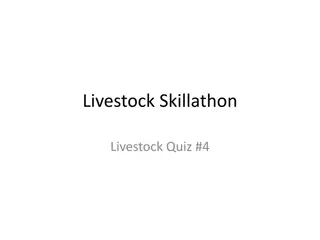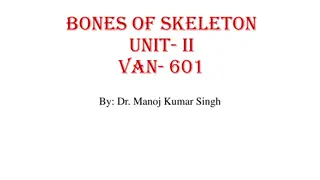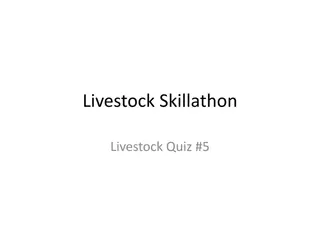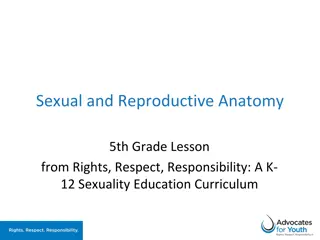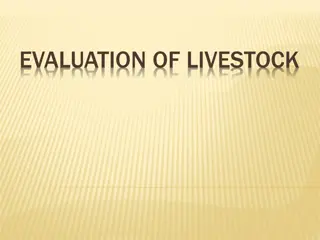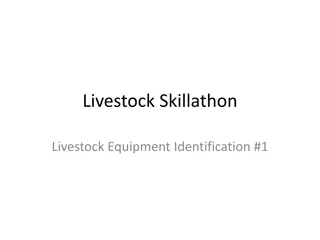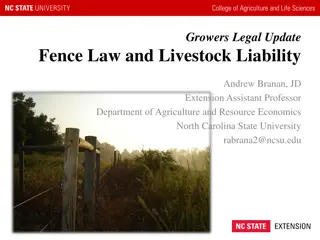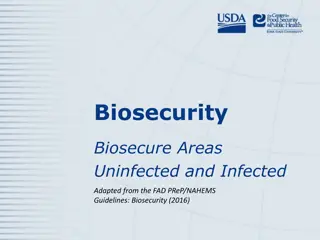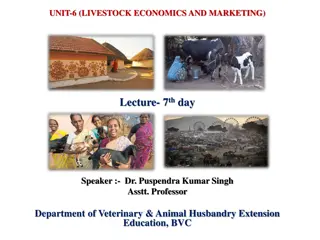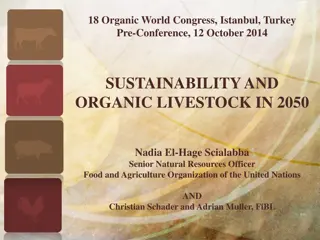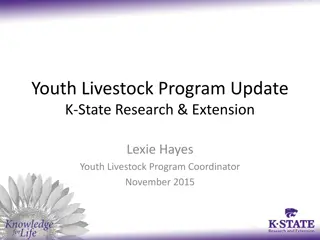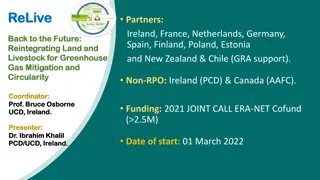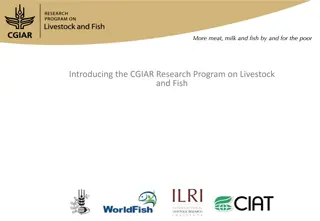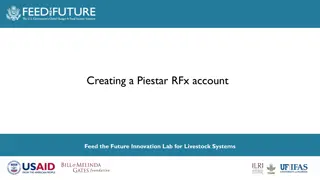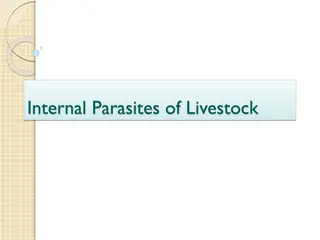Livestock Anatomy and Body Systems
Explore the anatomy of livestock, including the form, structure, and systems of the body. Learn about the skeletal, muscular, sensory, nervous, circulatory, respiratory, digestive, urinary, and reproductive systems. Discover body cavities, directions, and different systems and understand the functions and importance of the skeletal system in protecting vital organs and maintaining body structure.
Download Presentation

Please find below an Image/Link to download the presentation.
The content on the website is provided AS IS for your information and personal use only. It may not be sold, licensed, or shared on other websites without obtaining consent from the author.If you encounter any issues during the download, it is possible that the publisher has removed the file from their server.
You are allowed to download the files provided on this website for personal or commercial use, subject to the condition that they are used lawfully. All files are the property of their respective owners.
The content on the website is provided AS IS for your information and personal use only. It may not be sold, licensed, or shared on other websites without obtaining consent from the author.
E N D
Presentation Transcript
Anatomy Form and structure of the body and its parts What things look like and where they are located
System of the body Organs in the body Job or function Skeletal bones Protects vital organs Muscular Muscle(meat) Support and move body Sensory Eyes, ears, nose, skin Sense and detect things outside the body Nervous Brain, nerves spinal cord Pass messages around the body, control the body Circulatory Heart, blood vessels The blood carries substances around the body Respiratory Muzzle, windpipe, lungs Breathing Digestive Stomach, liver, intestine, pancreas Digest and absorb feed Urinary Kidneys, bladder Gets rid of poisons and waste Reproductive Testes, penis, ovaries, uterus, vagina, vulva, udder To produce and feed young
Body Cavities Ventral body cavity Contains most of the soft organs; divided by thin diaphragm Thoracic cavity- heart, lung, esophagus, blood vessels Abdominal cavity- digestive tract Pelvic cavity- urinary organs, reproductive organs Dorsal body cavity Contains the brain and spinal cord Cranial cavity- brain Spinal cavity- spinal cord
Cranial Cavity Spinal Cavity Dorsal Cavity Ventral Cavity Thoracic Cavity Abdominal Cavity Diaphragm
Different Systems Skeletal system Muscular system Sensory system Nervous system Circulatory system Respiratory system Digestive system Urinary system Reproductive system
Skeletal System Bony tissue Framework from the animals body The size and shape of animals is determined by the skeleton
The Skeletal System Functions Protection for vital organs Helps keep organs properly arranged in the body
Skeletal System Compact bone Honeycombed Hard part of the skeleton Bony tissue Calcium Phosphorus
Skeletal System Cartilage Flexible at the ends of bones Flexible material that lubricates the joints and cushion shocks
Muscular System The largest system in the body, making up about 45% of the body weight of hogs, cattle, and chickens Lean meat of animals
Muscular System Important for movement Locomotion Circulation Digestion Breathing
Muscular System Two types of muscles Voluntary: controlled by the thinking part of the brain Involuntary: automatically controlled by a lower part of the brain
Nervous System Provided animals with ability to react or adjust to different situations Helps with physical activity Provides pathways for all the senses Central Nervous System has the brain and spinal cord Peripheral Nervous System has somatic nerves which is muscles and skin and autonomic nerves which is the visceral organs
Sensory The brain also controls the senses. Different organs are: The eyes for sight The ears for hearing The nose for smell The tongue for taste The skin for touch
Circulatory Moves digested food, oxygen, wastes, and other materials around the body. Systematic circulation is the movement of blood throughout the body
Circulatory System Blood-liquid in the circulatory system Plasma-90% water Solid materials- glucose, vitamins, minerals, and amino acids (proteins)
Circulatory System Solids in the blood include: Red blood cells Contain hemoglobin Made in the bone marrow White blood cells Help fight off disease Pus that forms at wounds is a collection of white blood cells Platelets Essential for blood to clot
Circulatory System System parts Heart: Pump that sends blood throughout the system Arteries: Vessels that carry blood from the heart Capillaries: Small branches from the arteries that carry blood to the cells Veins: Carry blood back to the heart
Respiratory System Moves gases to and from the circulatory system Internal respiration Exchange of gases between the cells and the blood within the body External respiration Exchanges of gases in the lungs between the blood and the atmosphere
Respiratory System Parts of the Respiratory system Nostrils: openings near the mouth through which gases enter and leave the body Pharynx: connects the nose area with the mouth area Larynx: often called voice box Trachea: known as the windpipe; connects the pharynx with the lungs Lungs: where gas is exchanged between the atmosphere and the blood
Respiratory System Breathing process involves air entering and leaving the lungs Inspiration: process of taking air into the lungs Expiration: Process of moving air out of the lungs
Digestive System Consists of the teeth, mouth, esophagus, stomach, intestine, liver, pancreas, and rectum Begins in mouth where food is broken down into smaller pieces. In stomach it is mixed with juices to form soft paste. Then passes through intestine where bile from liver and juices from pancreas are added. Waste collects in rectum and passes out through anus (or cloaca in birds)
Digestive System Different livestock species have different digestive systems Ruminants have four compartments to stomach Rumen, reticulum, omasum, abomasum Poultry have a crop, proventriculus and ventriculus
Digestive System Monogastric Simple stomach One compartment Pigs Horse Dog Cat Birds
Endocrine System The endocrine system functions are Controls growth Reproductive functions Heat Lactation birth Shape of the animal Feed efficiency
Urinary System Main organ are the two kidneys, which lie against the backbone and bladder Waste materials and water are taken out of the blood in kidneys Forms urine which is then collects in bladder and passes out of the body
Urinary System Kidney s are shaped differently for different livestock Lobulated Cattle Chicken Heart shaped Horse Bean shaped Pigs Sheep
Reproductive System Two different reproductive systems: Female produces eggs from ovaries and gives birth Male produces sperm from testis and fertilizes the egg
Female Reproductive System Consists of two ovaries, one on each side of abdomen. Ovaries produce eggs which pass into the uterus. Below the uterus is the vagina which opens to the outside surrounded by vulva.
Male Reproductive System Male reproductive organs, the testicles, lie in the scrotum behind the penis Testicles produce the sperm in the semen In the bird the testicles are inside the body
References www.lsu.edu/lata/L3-1.doc http://www.fao.org/docrep/t0690e/t0690e04 .htm
